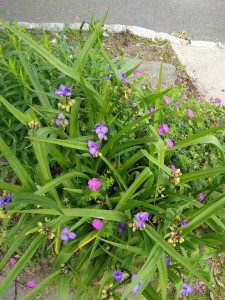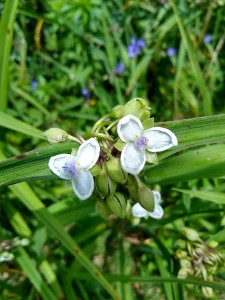 Garden spiderwort or Tradescantia x andersoniana is one of those plants that invariably pops up on lists of flowering specimens for partial shade. To say that it flowers is an understatement. It actually rampages. A mature clump of spiderwort may boast scores of flowers, but it conceals another talent—self seeding. Right now I am up to my eyebrows in spiderworts, with big clumps at every turn. Most feature traditional blue-purple flowers, but some have white, pale purple or blue ones. I think I planted one pot of the common blue- purple type long ago and possibly one pot of the white-flowered variety. The proliferation has happened without my help.
Garden spiderwort or Tradescantia x andersoniana is one of those plants that invariably pops up on lists of flowering specimens for partial shade. To say that it flowers is an understatement. It actually rampages. A mature clump of spiderwort may boast scores of flowers, but it conceals another talent—self seeding. Right now I am up to my eyebrows in spiderworts, with big clumps at every turn. Most feature traditional blue-purple flowers, but some have white, pale purple or blue ones. I think I planted one pot of the common blue- purple type long ago and possibly one pot of the white-flowered variety. The proliferation has happened without my help.
Spiderwort is a medium-tall, somewhat leggy plant with long green leaves and clusters of three-petaled flowers that bloom at the tops of the stalks. Some reference sources will tell you that those stalks top out at two feet tall. In my garden, vigorous specimens make it to nearly three feet. The individual blossoms, which start out as clusters of dangling beads at the tops of the stems, open out into three-petaled blooms centered on prominent golden stamens. Individual flowers last only one day, but mature plants produce so many buds that they appear to be in constant bloom for at least ten days to two weeks.
Native plant experts know Tradescantia virginiana, the most common tradescantia species found in the northeast. It is one of the parent species of Tradescantia x andersoniana, the hybrid from which most of the widely available cultivars have been bred.
The great eighteenth century plant taxonomist, Linnaeus, named the genus for John Tradescant, the Elder, 1570-1638, and John Tradescant, the Younger, 1608-1662, a father and son duo who were explorers, horticulturists and renowned collectors of curiosities. Serving various noble and royal patrons, including the ill-fated King Charles I and his queen, Henrietta Maria, the elder Tradescant traveled extensively in Europe, Asia Minor and North Africa, collecting plant materials and a vast array of other interesting objects. The former were installed in his botanical garden in the London’s Lambeth Borough, and the latter found their way to Tradescant’s large house, which was nicknamed “The Ark.” Eventually the contents of “The Ark” became the core of the collection that is now housed at Oxford’s Ashmolean Museum.
John Tradescant the Younger ventured even farther afield than his father, making several trips to Colonial Virginia and bringing back all sorts of native American plants and trees, including the tulip tree and the magnolia. In time he succeeded the elder Tradescant as Royal Gardener, and after managing to survive the English Civil War, he secured the patronage of the restored king, Charles II.
John Tradescant the Elder received seeds or plants of Tradescantia virginiana from contacts in the young colony around 1629, and installed them in his garden. The American specimens prospered and have continued to do so in many cultivated spaces around the world.
Tradescantia—species and cultivated varieties—are garden stalwarts for the same reason that they dominate my shady beds and borders—they are tough, hardy, beautiful and require almost nothing except hard pruning after the last petal drops. This is an important step that removes ugly, drooping stalks and sets the stage for a second flush of bloom later in the growing season.
An intelligent selection of tradescantia hybrids and cultivars can lighten shady spaces with a mix of pale lilac, blue, blue-purple, red-purple, pink and true purple flowers.
‘Purple Profusion’, with its purple tinged foliage, is an especially floriferous version of the traditional, purple-flowered spiderwort. ‘Concord Grape’ amps up the color volume with flowers in a brighter, fruity shade. I think my white-flowered specimen is “Snowcap’, which seems a tad less rampant than its darker-flowered relatives. I love the mauve ‘Osprey’, with blooms that feature pale blue central “eyes”. If your fancy tends towards a reddish-purple flower, consider ‘Red Cloud’ or ‘Valour’. Lovers of rosy shades will drink in ‘Pink Chablis’, which has pale pink flowers.
If you want the added brightness of golden green foliage, purple-flowered ‘Sweet Kate’ will get the job done. ‘Cearulea Plena’ is hard to find, but shines with double blue blooms. For limited spaces or containers, plant blue ‘Lord Nelson’.
Tradescantia can be rambunctious, as it is in my garden, but it is not hard to grub out the unwanted seedlings. Soil quality is less important than light; the spiderworts definitely need at least partial shade or the flowers will shrivel and the leaves will burn. It also helps to mulch thoroughly, especially if your shady space tends to be a bit dry. When you do the post-bloom shearing, cut the stalks nearly to the ground. Water during dry spells and new growth will follow quickly.
Local garden centers usually carry one or two tradescantia selections in the “Shade Plant” section. For more choices, try Bluestone Perennials, 7211 Middle Ridge Rd. Madison, OH 44057; 800-852-5243; www.bluestoneperennials.com. Free print catalog.
